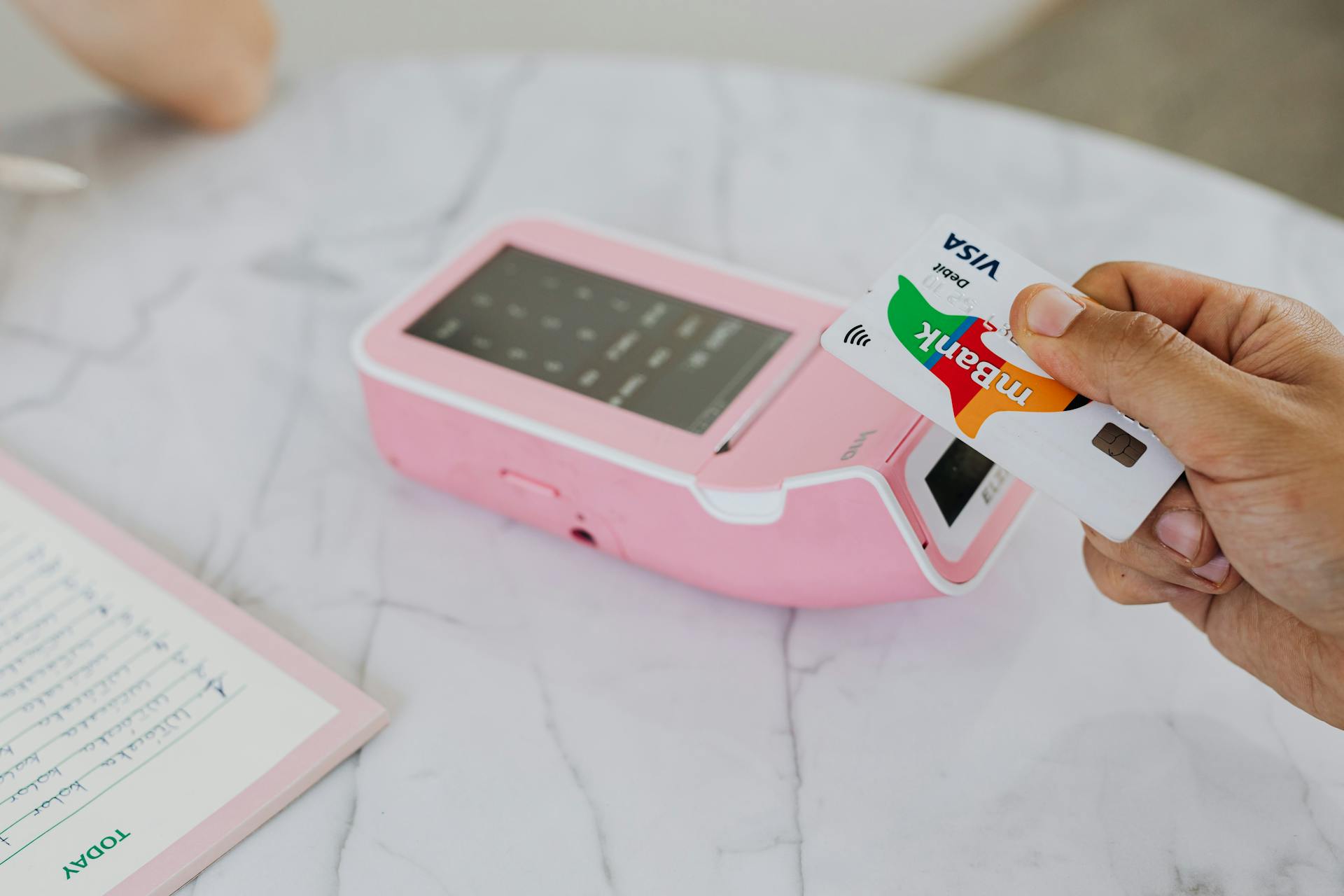
As a service provider, ensuring PCI DSS compliance is crucial to protect sensitive cardholder data. Service providers must have a robust security framework in place to safeguard this data.
To achieve this, service providers must implement a variety of security measures, including encryption of cardholder data, secure access to systems and networks, and regular security audits and risk assessments.
One of the key requirements for service providers is to maintain a secure network, which includes installing and maintaining a firewall configuration to protect cardholder data.
Regular security audits and risk assessments are also essential to identify vulnerabilities and ensure compliance with PCI DSS requirements.
If this caught your attention, see: Card Data Covered by Pci Dss Includes
What Is PCI DSS?
PCI DSS is a set of technical and operational standards that businesses follow to secure and protect credit card data.
The Payment Card Industry Data Security Standard (PCI DSS) is mandated by credit card companies to ensure the security of credit card transactions.
It's developed and managed by the PCI Security Standards Council, which is responsible for creating and updating the standards.
Businesses that handle credit card transactions must adhere to these standards to maintain PCI compliance.
If this caught your attention, see: Pci Compliance for Storing Credit Card Information
Becoming a PCI DSS Service Provider
To become a PCI DSS service provider, you must understand the definition of a service provider. According to the PCI DSS Glossary of Terms, a service provider is a business entity that is not a payment brand, directly involved in the processing, storage, or transmission of cardholder data on behalf of another entity.
Service providers can include companies that provide services that control or could impact the security of cardholder data, such as managed service providers, hosting providers, and other entities. If your business can affect the security of payment data belonging to another organization, you are considered a service provider.
Some examples of service providers include payment gateways, tokenization providers, hosted e-commerce shopping cart providers, and data center providers. These types of service providers may not store, process, or transmit cardholder data directly but focus on providing services designed to simplify or secure their client’s payment environments.
You might like: First Data Pci Compliance
What Makes Me a Provider?
Being a PCI DSS service provider can be a bit confusing, especially if you're not sure if you qualify. According to the PCI DSS Glossary of Terms, a service provider is a business entity that's not a payment brand, directly involved in the processing, storage, or transmission of cardholder data on behalf of another entity.
This can include companies that provide services that control or could impact the security of cardholder data, such as managed service providers, hosting providers, and other entities. If your business can affect the security of payment data belonging to another organization, you're considered a service provider.
Examples of service providers include payment gateways, tokenization providers, hosted e-commerce shopping cart providers, and data center services. These types of service providers don't always store, process, or transmit cardholder data directly, but they provide services designed to simplify or secure their client's payment environments.
To determine if you're a service provider, consider the following:
- Do you provide services that control or could impact the security of cardholder data?
- Do you store, process, or transmit cardholder data on behalf of another entity?
- Do you provide services that simplify or secure your client's payment environments?
If you answered yes to any of these questions, you may be considered a service provider and need to consider PCI DSS compliance requirements.
Revenue Management
As a PCI DSS Service Provider, revenue management is a crucial aspect to consider. The PCI DSS GUIDE clarifies the process of PCI DSS compliance, which can be complex and time-consuming.
To preserve security while navigating the compliance process, it's essential to have a solid understanding of the requirements. The PCI DSS GUIDE aims to provide common sense for the process, helping you avoid unnecessary risks.
Revenue management involves handling sensitive customer information, which is a critical aspect of PCI DSS compliance. PCI DSS GUIDE's aim is to help you preserve security while moving through the compliance process.
By following the guidelines outlined in the PCI DSS GUIDE, you can ensure that your revenue management practices are secure and compliant.
You might enjoy: Cyber Security Pci Compliance
Security Requirements
As a PCI DSS service provider, one of the most critical aspects of compliance is meeting the security requirements set forth by the PCI SSC.
To protect cardholder data, you must install and maintain a firewall configuration (Requirement 1). This includes not using vendor-supplied defaults for system passwords and other security parameters (Requirement 2).
Curious to learn more? Check out: Pci Dss Requirement 10
Protecting stored cardholder data is also a top priority. This means encrypting data using industry-accepted algorithms, such as AES-256 or RSA 2048, and truncating or tokenizing data when possible (Requirement 3).
To ensure the security of systems and applications, you must develop and maintain secure systems and software (Requirement 6). This includes deploying critical patches in a timely manner and configuring systems to prevent vulnerabilities.
Restricting access to cardholder data is also essential. This means implementing physical access controls, such as video cameras and electronic access control, to monitor entry and exit doors of physical locations (Requirement 9). You should also implement an access process that distinguishes between authorized visitors and employees.
Here are the 12 security requirements of PCI DSS:
- Install and maintain a firewall configuration to protect cardholder data
- Do not use vendor-supplied defaults for system passwords and other security parameters
- Protect stored cardholder data
- Encrypt transmission of cardholder data across open, public networks
- Use and regularly update anti-virus software or programs
- Develop and maintain secure systems and applications
- Restrict access to cardholder data by business need to know
- Assign a unique ID to each person with computer access
- Restrict physical access to cardholder data
- Track and monitor all access to network resources and cardholder data
- Regularly test security systems and processes
- Maintain a policy that addresses information security for all personnel
By meeting these security requirements, you can ensure the protection of cardholder data and maintain compliance with the PCI DSS standard.
Assessment and Validation
Assessment and validation are crucial steps in ensuring PCI DSS compliance for service providers. Compliance validation involves evaluating and confirming that security controls and procedures have been implemented according to the PCI DSS.
This is done through an annual assessment, either by an external entity or by self-assessment. Service providers have several additional security requirements that must be validated as part of their assessment.
A Qualified Security Assessor (QSA) is an individual certified by the PCI Security Standards Council to validate another entity's PCI DSS compliance. QSAs must be employed and sponsored by a QSA Company, which also must be certified by the PCI Security Standards Council.
Service providers have unique security requirements that must be validated as part of their assessment. This includes regular testing of security systems and processes, such as a quarterly wireless analyzer scan and a quarterly internal vulnerability scan.
Here are some key steps in the assessment process:
- Wireless analyzer scan to detect and identify all authorized and unauthorized wireless access points on a quarterly basis.
- All external IPs and domains exposed in the CDE are required to be scanned by a PCI Approved Scanning Vendor (ASV) at least quarterly.
- Internal vulnerability scan must be conducted at least quarterly.
- All external IPs and domains must go through exhaustive Application penetration test and Network penetration test at least yearly or after any significant change.
What Are the Levels?
Service providers are categorized into two levels of compatibility based on their annual transaction volume.
Level 1 Service Providers have more than 300 thousand transactions per year. This is also true for Amex, which requires more than 2.5 million transactions per year.
Service providers with fewer transactions are classified as Level 2 Service Providers, with less than 300 thousand transactions per year. This is also true for Amex, which requires less than 2.5 million transactions per year.
All service providers, regardless of level, are required to be PCI compliant by Mastercard, Visa, Amex, and Discover.
Here's a breakdown of the two levels:
Security Assessors
Security assessors are a crucial part of ensuring the security and compliance of payment card data.
The PCI Security Standards Council maintains a program to certify companies and individuals to perform assessment activities.
To become a certified security assessor, you'll need to meet specific requirements and pass a certification process.
A Qualified Security Assessor (QSA) is an individual certified by the PCI Security Standards Council to validate another entity's PCI DSS compliance. QSAs must be employed and sponsored by a QSA Company, which also must be certified by the PCI Security Standards Council.
Suggestion: Pci Dss Qsa Certification
Internal Security Assessors (ISAs) are individuals who have earned a certificate from the PCI Security Standards Council for their sponsoring organization, and can conduct PCI self-assessments for their organization.
Here are the main differences between QSAs and ISAs:
Self-Assessment Questionnaire
The PCI DSS Self-Assessment Questionnaire (SAQ) is a validation tool for small to medium sized merchants and service providers to assess their own PCI DSS compliance status.
There are multiple types of SAQ, each with a different length depending on the entity type and payment model used.
Each SAQ question has a yes-or-no answer, and any "no" response requires the entity to indicate its future implementation.
An attestation of compliance (AOC) based on the SAQ is also completed.
Intriguing read: Pci Dss 4.0 Saq Types
Validation of Compliance
Validation of compliance is a crucial aspect of the PCI DSS, and it's not just a one-time thing. Compliance validation involves an annual assessment, which can be done either by an external entity or through self-assessment.
A unique perspective: Pci Dss Risk Assessment
There are different types of entities that need to undergo validation, including merchants and service providers. According to the PCI Security Standards Council, merchants and service providers must be validated according to the PCI DSS, and Visa offers an alternative program called the Technology Innovation Program (TIP) for qualified merchants.
Issuing banks are not required to undergo PCI DSS validation, but they must secure sensitive data in a PCI DSS-compliant manner. Acquiring banks, on the other hand, must comply with PCI DSS and have their compliance validated with an audit.
The PCI DSS Self-Assessment Questionnaire (SAQ) is a validation tool for small to medium sized merchants and service providers. There are multiple types of SAQ, each with a different length depending on the entity type and payment model used.
Here are the different types of SAQ:
By understanding the different types of SAQ and validation requirements, you can ensure that your entity is compliant with the PCI DSS and avoid any potential penalties.
12.8
To ensure your service provider is PCI compliant, you need to regularly test their security systems and processes. This is a requirement under PCI DSS, specifically Requirement 11.
Testing is crucial because vulnerabilities are being discovered continually by malicious individuals and researchers. This means all systems and processes must be tested on a frequent basis to ensure security is maintained.
You need to conduct the following periodic activities: a wireless analyzer scan to detect and identify all authorized and unauthorized wireless access points on a quarterly basis, a quarterly scan of all external IPs and domains exposed in the cardholder data environment (CDE) by a PCI Approved Scanning Vendor (ASV), an internal vulnerability scan at least quarterly, and an exhaustive Application penetration test and Network penetration test at least yearly or after any significant change.
Additionally, file monitoring is a necessity, and the system should perform file comparisons each week to detect changes that may have otherwise gone unnoticed.
Here's a summary of the required testing activities:
Reporting and Requirements
Companies subject to PCI DSS standards must be PCI-compliant, with their reporting level determined by their annual number of transactions and how the transactions are processed.
There are four merchant levels: Level 1 – over six million transactions annually, Level 2 – between one and six million transactions, Level 3 – between 20,000 and one million transactions, and Level 4 – less than 20,000 transactions.
Each card issuer maintains a table of compliance levels and a table for service providers, which can be used to determine the reporting level.
Service providers are categorized into two levels: Level 1 and Level 2.
Level 1 service providers store, process, or transmit more than 300,000 credit card transactions annually for Visa, Mastercard, and Discover, or more than 2.5 million for AMEX.
Level 2 service providers store, process, or transmit less than 300,000 credit card transactions annually for Visa, Mastercard, and Discover, or less than 2.5 million for AMEX.
Here's an interesting read: Pci Compliance Issues with Credit Card Authroization Forms
To ensure PCI compliance, Level 1 service providers must prepare an Annual Compliance Report (ROC) prepared by a Qualified Security Auditor (QSA), and perform network scans quarterly by the Approved Scanning Provider (ASV).
Level 2 service providers must evaluate themselves annually with the Self-Assessment Questionnaire SAQ-D.
Here is a summary of the requirements for Level 1 and Level 2 service providers:
- Level 1 service providers:
- Annual Compliance Report (ROC) prepared by a Qualified Security Auditor (QSA)
- Network scans performed quarterly by the Approved Scanning Provider (ASV)
- Penetration test performed annually
- Quarterly local network vulnerability scans
- Declaration of Conformity (AOC) Form
- Level 2 service providers:
- Annual PCI Self-Assessment Questionnaire (PCI SAQ) D
- Network scans performed quarterly by the Approved Scanning Provider (ASV)
- Penetration test performed annually
- Quarterly local network vulnerability scans
- Declaration of Conformity (AOC) Form
Frequently Asked Questions
What is the difference between PCI DSS Level 1 and 2?
PCI DSS compliance levels differ by transaction volume: Level 1 is for large providers with over 300,000 annual transactions, while Level 2 is for smaller providers with under 300,000 transactions per year
What are the requirements for PCI DSS service provider Level 2?
To maintain PCI DSS compliance as a Level 2 service provider, you must complete an annual PCI Self-Assessment Questionnaire (PCI SAQ D) and undergo quarterly network scans and annual penetration testing. This ensures the security of sensitive cardholder data.
Sources
- https://www.securitymetrics.com/blog/pci-dss-compliance-service-providers-faq
- https://pcidssguide.com/what-are-pci-service-provider-compliance-levels/
- https://www.prevalent.net/blog/pci-third-party-service-provider-requirements/
- https://en.wikipedia.org/wiki/Payment_Card_Industry_Data_Security_Standard
- https://www.controlcase.com/what-are-the-12-requirements-of-pci-dss-compliance/
Featured Images: pexels.com


